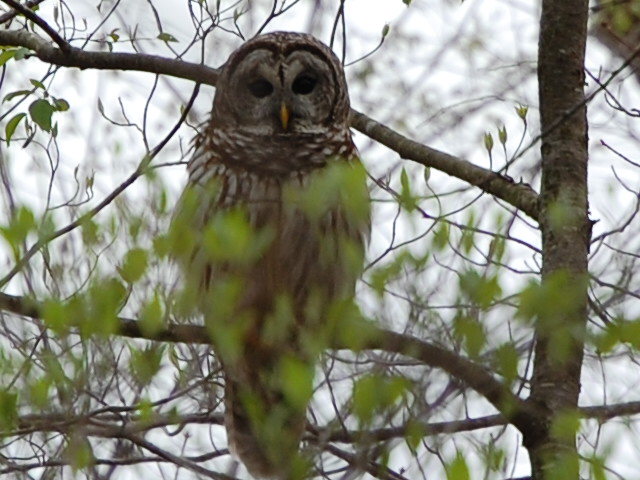Winter is a time for observations in nature. The architecture of an Ozark hardwood forest, the silence of the woods after freshly fallen snow, and the intricacies of persimmon bark are often overlooked in most seasons. Maybe the best observation for this time of year is to notice our native bird population. All of our trails are populated with year-round species of songbirds and birds of prey such as the Carolina Chickadee, the Eastern Bluebird and the Great Horned Owl. It doesn’t take long before you hear the rapping of a Red-Bellied Woodpecker or the tik of a Northern Cardinal.
One species is a favorite of staff: the Barred Owl. Although at times difficult to spot, you can hear its muffled who-cooks-for-you call throughout the woods. This medium-sized owl grows up to 20 to 22 inches tall and helps us control our rodent and amphibian population. The Barred Owl has been spotted on the Orchard Trail, Dogwood Trail, and Rock Ledge Trail.
You will often see large dead trees in our forest. Called snags, they serve a very important role in our ecosystem. They provide shelter and a place to raise young for several species of birds. They also provide a breeding ground for food sources such as carpenter ants and beetle larvae, which are very desirable to the Pileated Woodpecker. You not only hear the loud drumming of this woodpecker, but you can also hear its ke-ke-ki-ki-ki call echoing very loudly throughout our site. This largest of the woodpecker species, it grows up to one and a half feet tall and is unmistakable.
Next time you think there isn’t much to see in the winter, please visit our trails and observe what nature has to offer during this time of year.
-Cody
Editor’s Note: Crystal Bridges’ resident Barred Owl is the mascot for our regular Art Night Out events. Creative Director Anna Vernon designed the logo, with our owl as her model — LD: 







